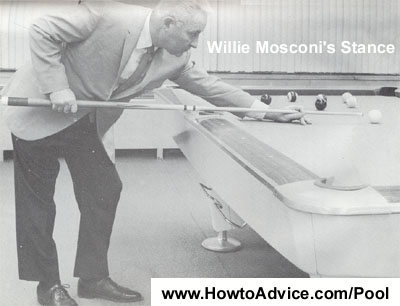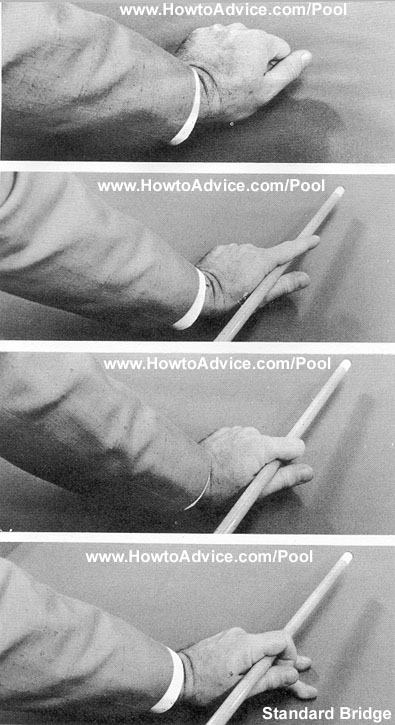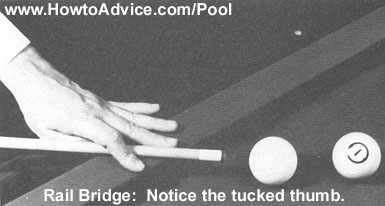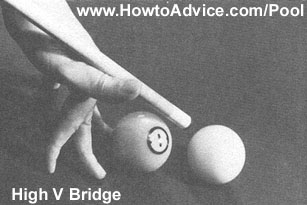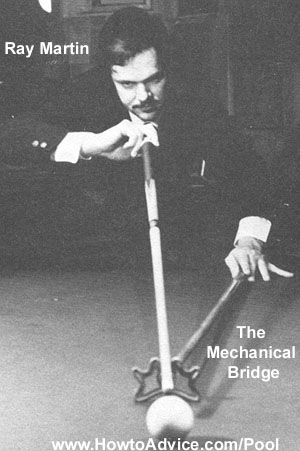Advance Your Pool Game
by Lonnie Lee Best
|
Table of Contents: |
|
 Buy Now
|
Introduction
Has your pool game plateaued?
It happens to a lot of pool players. They reach a certain level of
proficiency, and can't seem to get any better. The most common cause of
this frustrating condition is that they have built their game on bad
fundamentals. One can become a pretty good pool player with bad
fundamentals, but there comes a point where practice can't overcome the
limitations caused by subtle fundamental shortcomings.
If you are just beginning to learn how to play pool. You can save yourself a lot of frustration by building your game on the solid fundamentals provided here. If you do this, your ability to progress will be unlimited.
If you are a seasoned player that has reached a plateau. I suggest that you bookmark this page, and review your fundamentals every time you reach a point in which you are unable to progress.
The Fundamentals of Pool
"Weight must be evenly distributed and the body perfectly poised so that there is no movement on the stroke apart from that of the striking arm" (Pulman 14).
"All you have to do is provide a support for the cue that enables it to move back and forth without wobbling from side to side. It is up to you to find a comfortable way to hold your fingers. Only when you are shooting hard or using a lot of sidespin is it necessary to form a "looped" bridge. On most shots and open or V bridge is sufficient and even an advantage because the entire shaft is visible for aiming" (Byrne 2).
"Because the standard bridge is the one your will be using for 90 percent of your shots, it deserves most of your attention and practice. It's as easy as clenching your fit. In fact, start by making a fist with your left hand. Extend your left arm and place your fist on the table, palm down. Open your thumb and forefinger and lay the cue along your thumb between the knuckles. Draw your forefinger down over the top of the cue and use your thumb to press the fingertip against the middle knuckle of your second finger. You now have a channel through which the cue can slide, but that's not enough. A billiard bridge needs a base of support broader than a fist. With the heel of your hand resting on the table, separate and extend the last three fingers into as wide an area of support as possible without strain. You now have four distinct and solid contacts with the table and have "built" a sound bridge of finger-girders and a palm-heel pedestal" (Mosconi 37).
- Medium - If a shot requires you to hit the center of the cue ball, the basic bridge should be a the proper elevation for this.
- High - If a shot requires you to hit high on the cue ball, then the basic bridge must be adjusted to the proper elevation. Bringing the fingers closer together toward you palm, while maintaining stability, can do this.
- Low - If a shot requires you to hit low on the vertical axis of the cue ball, then the basic bridge must be lowered. This can be achieved by spreading the fingers apart and away from the palm.
When the cue ball is so close to the rail that is prevents you from using a standard bridge, employ this rail bridge by tucking back your thumb and sliding the cue between your first two fingers.
- Regular V - Unlike the basic bridge, in which the player controls the cue by letting it fit snugly into a channel formed by the thumb and forefinger, "beginners simply rest the cue in the crotch between the thumb and forefinger, which is a V-bridge. Although it gives less control, occasionally even expert players us it for certain shots" (Martin 220).
- High V - This bridge is used when placement of any of the preceding bridges is obstructed by an interference ball. This bridge allows you to shoot over balls between you and the cue ball.
The mechanical bridge is used on shots in which placement of any of the preceding bridges is out of reach.
The "where" and "how" of your right hand grip at the butt end of the cue are of equal importance. Where you grip the cue determines your ability to stroke freely and smoothly. How you grip the cue is a vital factor in the delicate touch and full follow-through so important to successful shotmaking" (Mosconi 29).
- Find the balance point.
- Slide your hand back from 4 to 7 inches behind this balance point, until the cue feels right and easy in your hand.
- "Grip the cue firmly, yet lightly, with your thumb, index and middle fingers" (Martin 14).
"Assume you are in position. Your stance and your bridge are proper. Your cue is chalked, and you have the proper grip. Your eyes are directly over the line of the cue and ball. Your are balanced and relaxed. At this point two elements come into play:
(1) Your pendulum, the swing of your arm from your elbow.
(2) Your follow-through, your "stroking" of the ball.
Actually one is part of the other, but it will help if we discuss them almost as though they were separate things." (Martin 21)
The Pendulum
Your forearm is swinging closely to your side, like a pendulum swung from your shoulder. The cue motion, is partly in the wrist and partly in the arm. However, your motions are fluid, Neither your hand nor your wrist is cramped. The pendulum is swinging back and forward - a fixed rhythm ready to deliver the cue tip to the proper part of the ball, so fixed and so automatic that you can actually shut your eyes and make the shot!" (Martin 21)
"But a perfect pendulum is only the beginning. Just as, in golf, a player swings through the ball, so in pool a player strokes through the ball. He shoots with a smooth flowing follow-through, as though the ball were not even there: and the cue increases in speed until contact, and then comes to a natural stop. Let us repeat: the cue come to a natural stop. It is not stopped by any "pulling" of the cue, but simply because the cue tip has reached the end of the stroke. Pulling causes flinching, inadvertent cue tip movement and loss of accuracy. It is important to remember, in developing a full stroke, that too long a backswing may make the cue tip swerve. Too short a backswing, and the stroke won't have an effortless follow-through and come easily to a natural stop" (Martin 23).
Byrnes, Robert. Advanced Techniques In Pool And Billiards. San Diego: Harcourt Brace Jovanovich, 1990.
Martin, Ray and Reeves, Rosser. The 99 Critical Shots In Pool. New York: Times Books, 1977.
Mosconi, Willie. Winning Pocket Billards. New York: Crown Publishers, Inc, 1965.
Pulman, John. Tackle Snooker This Way. London: Stanley Paul, 1965.
| The
99 Critical Shots in Pool by Ray Martin
I highly recommend this book. This book quickly, but thoroughly, covers the fundamentals before it teaches you how to control the cue ball and make seemingly difficult shots. This is not a trick shot book. The 99 shots are practical shots that come up all the time, but are often missed and often executed leaving the cue ball in a bad position. Ray Martin reveals the simple unapparent solutions. I rate this book a 99 out of 100, knocking one point off because of its name. |
|
| Advanced
Techniques in Pool and Billiards by Robert Byrne
This is not a book for beginners! This book will disabuse most players. However, if you think you know it all, get ready to be knocked off your high horse. Byrne is one the top instructors in the nation, and he tells it like it is. He not only points out the misconceptions that many players have, but those of instructors and writers too!!! Byrne also has an excellent beginner's book Byrne's New Standard Book of Pool and Billiards. |
|
| Winning
Pocket Billiards by Willie Mosconi
This is a classic book for beginners. Willie Mosconi is one of the best if not the best player to ever play the game. At age 7, Willie Mosconi played World Champion Ralph Greenleaf. After which, Greenleaf made the following accurate prediction: "Having defeated the seven-year-old Willie Mosconi 50 to 46, I have no hesitancy in saying he will be the future world's champion." I love the photographic illustrations in this book versus the computer generated diagrams of other beginner books. Mosconi did a good job covering the basics. |
|
| Virtual
Pool 3
This is an unbelievably realistic computer game. This is not like video games used to be. You feel like you have your stick in hand, and you are standing at a real live pool table. Heck, in some ways it is even better than the real thing. You don't have to worry about chalking your cue after every shot. |
Tell others about
this page:
Comments? Questions? Email Here



